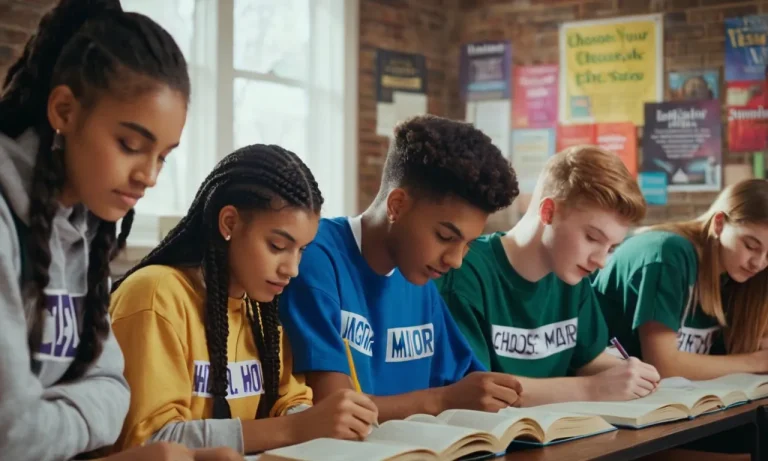Dropping out of high school can be a life-altering decision with far-reaching consequences. However, it’s not an irreversible one. Many individuals who left school prematurely find themselves yearning for a second chance to complete their education and unlock new opportunities.
If you’re short on time, here’s a quick answer to your question: Yes, you can go back to high school after dropping out. Various options exist, including re-enrolling in a traditional high school, attending an alternative school, or pursuing a GED (General Educational Development) diploma.
In this comprehensive guide, we’ll explore the different pathways available for those seeking to return to high school after dropping out. We’ll delve into the requirements, processes, and potential challenges, as well as the benefits of completing your secondary education.
Understanding the Importance of a High School Diploma
Obtaining a high school diploma is a crucial milestone that opens doors to numerous opportunities in life. It’s a testament to perseverance, dedication, and a commitment to personal growth. The importance of this achievement cannot be overstated, as it lays the foundation for a brighter future.
Educational and Career Opportunities
A high school diploma is often the minimum requirement for many jobs and higher education programs. Without it, individuals face significant limitations in their career paths and earning potential. According to the National Center for Education Statistics, the median annual earnings for individuals with a high school diploma are approximately 30% higher than those without a diploma.
Moreover, a diploma paves the way for further academic pursuits, such as attending college or vocational training programs, which can lead to even greater career prospects and financial stability.
Personal Growth and Self-Confidence
Completing high school is not just about acquiring knowledge; it’s also a journey of personal growth and self-discovery. The challenges faced and overcome during this time foster resilience, discipline, and a sense of accomplishment.
Graduating instills a sense of pride and boosts self-confidence, empowering individuals to tackle life’s obstacles with determination and a positive mindset. This newfound confidence can have a ripple effect, influencing various aspects of one’s life, from interpersonal relationships to professional endeavors.
Breaking the Cycle of Poverty
Education is often hailed as a powerful tool for breaking the cycle of poverty. By obtaining a high school diploma, individuals significantly increase their chances of securing well-paying jobs and achieving financial stability. This, in turn, can positively impact their families and communities.
According to a study by Child Trends, individuals who drop out of high school are more likely to face unemployment, rely on public assistance, and have lower lifetime earnings compared to those with a diploma.
By prioritizing education, individuals can pave the way for a brighter future and contribute to the overall economic well-being of society.
Options for Returning to High School
Dropping out of high school can be a tough decision, but the good news is that it’s never too late to go back and earn your diploma. Whether you left school due to personal circumstances, financial challenges, or simply lost motivation, there are several options available to help you get back on track.
Let’s explore them:
Re-enrolling in a Traditional High School
If you’re under a certain age (usually 21 or younger), you may be able to re-enroll in your local high school or a different one in your district. This option allows you to pick up where you left off and complete your coursework in a familiar setting.
Many schools have support programs in place to help students who have previously dropped out, such as counseling services and flexible scheduling. According to the National Center for Education Statistics, in 2019, approximately 5.1% of students dropped out of high school, so you’re not alone in this journey.
Alternative Schools and Programs
If the traditional high school setting doesn’t suit your needs or schedule, consider enrolling in an alternative school or program. These options often offer more flexible schedules, smaller class sizes, and personalized attention.
Some examples include charter schools, night schools, and adult education programs. Many community colleges also offer high school completion programs, which allow you to earn your diploma while taking college-level courses.
According to a study by Education Week, the number of alternative schools in the U.S. has been steadily increasing, providing more opportunities for students to find the right fit.
Online High School Courses
In today’s digital age, online high school courses have become a popular option for students who prefer a more self-paced or remote learning environment. These courses allow you to complete your coursework from the comfort of your own home or anywhere with an internet connection.
Many online high schools are accredited and offer a wide range of subjects, including core classes and electives. Some reputable online high school programs include Penn Foster High School and K12. According to a survey by Education Week, over 75% of high school students had taken at least one online course in 2015, highlighting the growing popularity of this option.
Obtaining a GED (General Educational Development) Diploma
If you’re unable to re-enroll in high school or prefer a more direct path to a high school equivalency credential, consider pursuing a GED (General Educational Development) diploma. The GED is a series of tests that cover the core subject areas typically taught in high school, including math, science, social studies, and language arts.
Passing the GED tests demonstrates that you have the knowledge and skills equivalent to a high school graduate. Many colleges, employers, and vocational programs accept the GED as an alternative to a traditional high school diploma.
According to GED Testing Service, over 20 million people have earned their GED since the program began in 1942, proving it’s a popular and respected option.
No matter which path you choose, the important thing is that you’re taking steps to further your education and open up more opportunities for your future. Don’t be discouraged – with determination and the right resources, you can absolutely achieve your goal of earning a high school diploma or equivalent.
Remember, it’s never too late to invest in your education and unlock your full potential!
Navigating the Re-enrollment Process
Returning to high school after dropping out can be a daunting task, but with the right preparation and support, it’s an achievable goal. The re-enrollment process typically involves gathering the necessary documents, meeting with school counselors, addressing academic gaps, and seeking support services.
Let’s explore each step in detail:
Gathering Required Documents
The first step in the re-enrollment process is to gather the required documents. This usually includes your birth certificate, immunization records, transcripts from your previous school, and proof of residency.
Some schools may also require additional documents, such as a parent or guardian’s identification or a statement of intent to re-enroll. It’s essential to have all the necessary paperwork in order to ensure a smooth re-enrollment process.
According to the U.S. Department of Education, schools should be flexible and provide alternative methods for families to submit documents during the COVID-19 pandemic.
Meeting with School Counselors
Once you have the required documents, you’ll need to schedule a meeting with a school counselor or administrator. This meeting is crucial as it allows you to discuss your reasons for leaving school and your goals for re-enrolling.
The counselor will assess your academic standing, determine the appropriate grade level, and help you create a plan to meet graduation requirements. They may also provide guidance on course selection, extracurricular activities, and support services available to you.
It’s essential to be open and honest during this meeting, as the counselor’s role is to help you succeed academically and personally.
Addressing Academic Gaps
After being out of school for a period, it’s likely that you’ll have some academic gaps to address. The school may require you to take placement tests or provide other assessments to determine your current skill levels in subjects like math, reading, and writing.
Based on the results, you may need to enroll in remedial courses or participate in tutoring programs to catch up. According to the National Center for Education Statistics, approximately 15% of students who drop out eventually re-enroll in high school.
😊 Addressing academic gaps early on can help ensure a smoother transition and increase your chances of success.
Seeking Support Services
Returning to school after dropping out can be challenging, and it’s essential to have a support system in place. Many schools offer various support services to help students succeed academically and personally.
These may include counseling services, mentoring programs, tutoring, and assistance with transportation or childcare. Don’t hesitate to ask about these resources during your meeting with the school counselor.
Utilizing support services can make a significant difference in your ability to stay motivated, overcome obstacles, and ultimately achieve your goal of earning a high school diploma.
Overcoming Challenges and Staying Motivated
Going back to high school after dropping out can be a daunting task, but it’s a challenge that many students have successfully overcome. One of the biggest hurdles is often balancing the demands of work, family, and school.
According to a study by the National Center for Education Statistics, approximately 16% of high school students work 20 hours or more per week while attending school. Juggling multiple responsibilities can be overwhelming, but it’s important to prioritize your goals and manage your time effectively.
Balancing Work, Family, and School
- Create a schedule that allocates time for work, family, and studying.
- Communicate openly with your employer and family about your commitments.
- Consider online or evening classes if they better fit your schedule.
Building a Support Network
Having a strong support system can make a significant difference in your journey back to high school. Surround yourself with people who believe in your goals and can offer encouragement and practical assistance.
This could include family members, friends, teachers, counselors, or even online communities. Don’t be afraid to ask for help when you need it – whether it’s with childcare, transportation, or academic support. 🙏
Setting Realistic Goals
While it’s important to dream big, it’s equally crucial to set realistic goals for yourself. Break down your overall objective into smaller, achievable milestones, and celebrate each victory along the way. This will help you stay motivated and focused on your progress.
Remember, every step forward is a step closer to your ultimate goal. 🎯
Celebrating Small Victories
Going back to high school is no easy feat, and it’s essential to recognize and celebrate your accomplishments, no matter how small they may seem. Did you ace a test? 🎉 Finish a challenging assignment? 👏 Attend class consistently for a month? 🙌 Take a moment to acknowledge your hard work and dedication.
Celebrating small victories will help you stay motivated and inspired to keep pushing forward.
Remember, you’re not alone in this journey. Many resources and support systems are available to help you navigate the challenges of returning to high school. Don’t hesitate to seek guidance and encouragement from professionals, such as school counselors or government-funded programs designed to assist adult learners.
With perseverance and a positive mindset, you can overcome any obstacle and achieve your educational goals. 💪
Conclusion
Returning to high school after dropping out is a courageous and commendable decision that can open doors to a brighter future. While the journey may be challenging, the rewards of completing your secondary education are invaluable.
With determination, perseverance, and the right support system, you can overcome obstacles and achieve your educational goals.
Remember, education is a lifelong pursuit, and it’s never too late to invest in yourself. By taking the first step towards re-enrolling, you’re paving the way for personal growth, increased opportunities, and a sense of accomplishment that will resonate throughout your life.
Embrace this second chance and embark on a transformative journey that will shape your future in profound ways.






